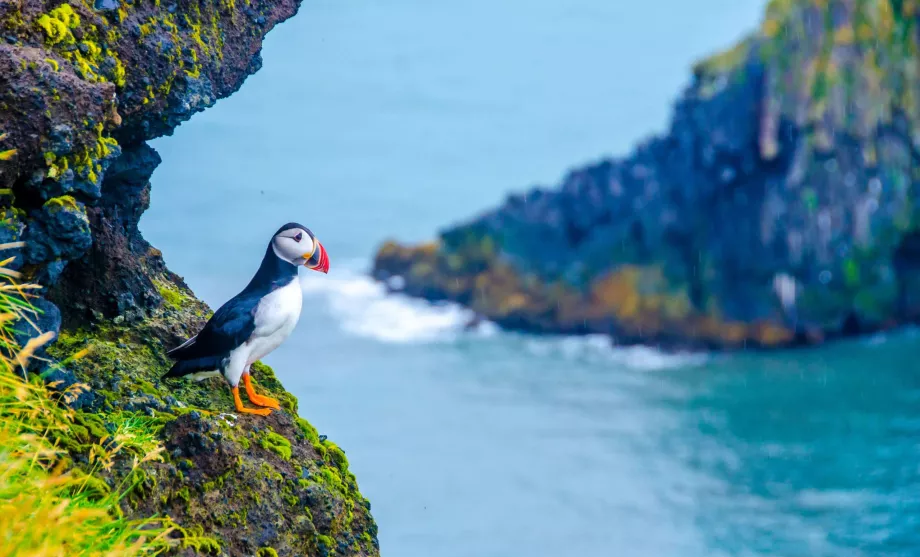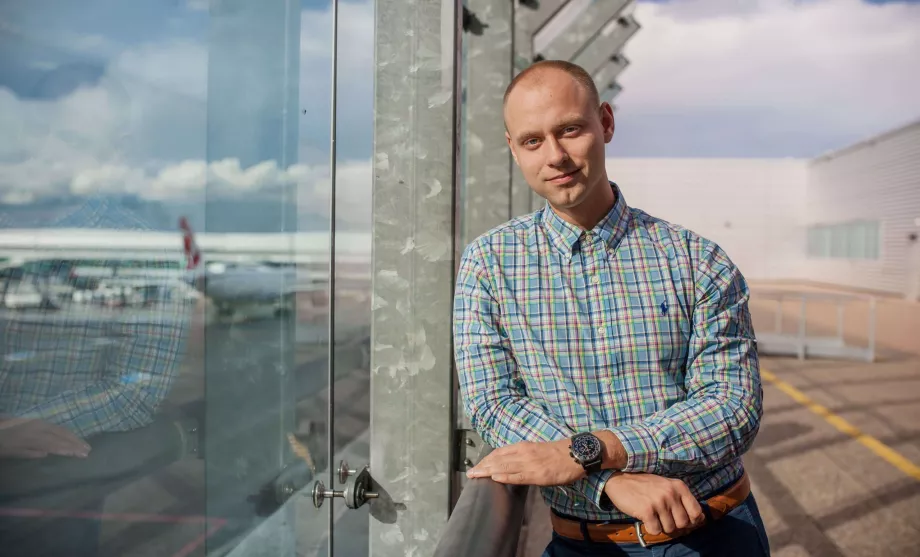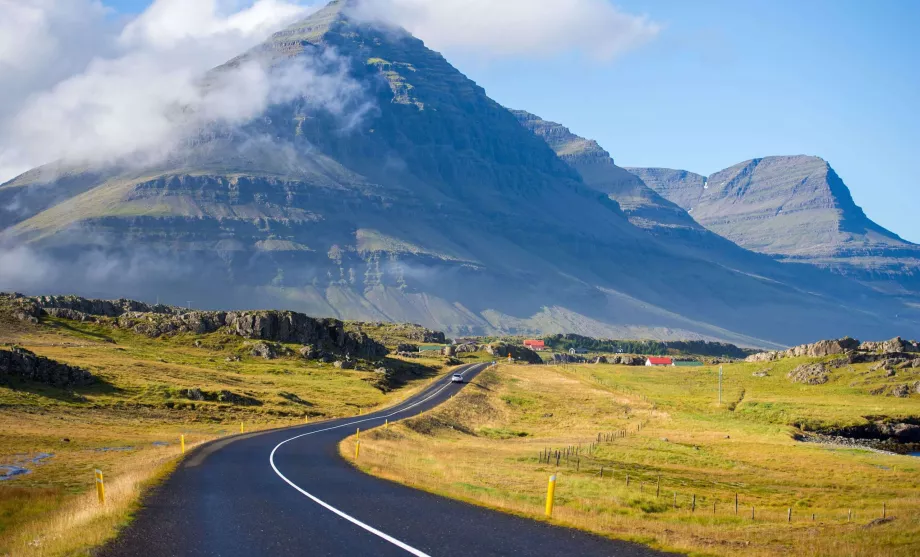Getting around Iceland

Practically the only way to get to know the island properly is by car. Public transport only works between towns and the frequency is not very high.
Paying for tourist buses works out significantly more expensive than renting a car, even after factoring in the price of gas. It may be worth it when travelling in one person, but never in 2 or more people.
Search for accommodation in Iceland
By car
Drive on the right in Iceland.
The traffic density here is quite sparse and you really won't get stuck in a traffic jam. The road network is not very dense, which is due to the terrain and the sparse population of Iceland.
There is one main road around the whole island, Route 1, otherwise known as „Ring road“. This route is very popular among travelers because it can take you around Iceland in a few days and you can admire the beauty of the Icelandic landscape along the way. However, some parts of it are gravel, so you need to be careful.
There are no tarmac roads through the centre of Iceland, only gravel mountain roads that are only open in the summer season. A great website for roads in Iceland with webcams for road conditions is www.road.is.
If you bring your own car to Iceland by ferry, there is no paperwork to deal with, it's like crossing the border into Austria or Germany.
For detailed information on driving in Iceland, car rental prices and traffic and roads, see the Car rental chapter.
Tourist buses
In the summer season you can also use tourist bus companies, the largest and best known are Reykajvik Excursions or Grayline. These specialise in organising excursions or even regular services that are not served by regular scheduled buses.
Destinations where you can go by bus from Reykjavík:
- Golden Circle - prices from 9 000 isk
- Landamannalaugar - prices from 14 000 isk
- Þórsmörk - prices from 15 000 isk
- Blue Lagoon - prices from 7 000 isk
- South Coast - many options from shorter half-day to 12-hour trips with prices varying between 12 000 isk and 25 000 isk
Timetables of tourist buses and links to buy tickets can also be found on nat.is.
Link buses
Ordinary public transport buses are operated by a single company in Iceland, Straetó. It operates long-distance services as well as public transport in Reykjavik and Akureyri. Buses are only worth using in Reykjavík. In the capital, there is a regular public transport system with about 30 lines, which have urban intervals of about 15 minutes on weekdays and 30 minutes on weekends.
Ticket prices in Reykjavik are relatively high. Fares can be paid with your own contactless card directly on the bus. There are only two types of tickets:
- Single - transferable for 75 minutes: 570 isk / 1 zone (the whole of Reykjavík is in 1 zone)
- Monthly: 8 000 isk
You always attach the card to the reader when boarding, you don't attach it when getting off. The card can only be recharged via klappid.is in the "My Pages" section.
It is more convenient to pay via the Klappid mobile app.
Intercity ticket prices are calculated by zone, i.e. 570 isk times the number of zones. However, you are very unlikely to use regular buses when travelling around Iceland. They don't usually stop at tourist attractions and when they do pass some, they only run once or twice a day at most, and even then not every day.
Bus timetables outside Reykjavik can be found on the straeto.is website. For example, the route from Reykjavík to the 2nd largest city Akureyri goes through 22 zones, i.e. you will pay for a ticket 10 780 isk. The journey to Keflavík Airport on bus line 55 then works out at 1 960 isk.
Air transport
Iceland also has a domestic air service, which is best used especially in winter when snow can make travelling by car difficult. Naturally, the cost of air travel is higher than if you used other means of transport, and a return ticket from Reykjavik to Akureyri will normally cost you 125 eur.
Domestic flights are operated by Icelandair, which can take you beyond the larger Icelandic cities to more remote areas of Iceland or Greenland. All domestic flights depart from Reykjavík RKV airport right in the city centre, not from Keflavík International.
Flights with Icelandair can be purchased cheaply via icelandair.com. If you will be buying your tickets through skyscanner.com, ideally click through to the airline's website directly.
The airline flies the following routes:
- Reykjavík (RKV) - Akureyri (AEY): convenient for a quick trip to the north of Iceland and car rental only in Akureyri
- Reykjavík (RKV) - Ísafjörður (IFJ): suitable when travelling to the wild Hornstrandir peninsula
- Reykjavík (RKV) - Egilsstaðir (EGS): suitable for a quick trip to the east of Iceland and car hire as far as Egilsstaðir
Norlandair is also an important regional airline, operating flights from Reykjavík (RKV) to the small airports of Bildudalur (BIU) and Gjögur (GJR) on the Westfjords peninsula, with return fares around 160 eur.
It also flies from Akureyri to the island of Grímsey and to the small northern airports of Thorshofn and Vopnafjordur with return fares around 120 eur. Tickets can only be bought on the norlandair.is/en website.
In addition, the small airline Eagle Air also flies from Reykjavik to Húsavík airport in the north of the island, Höfn airport on the far south coast and also to the Vestmannaeyjar archipelago. However, return ticket prices are exorbitant and start at about 300 eur. Tickets can only be purchased on the eagleair.is website.
Ferries
There are 4 public ferries operating within Iceland carrying both independent pedestrians and cars.
- Vestmannaeyjar archipelago from Landeyjahöfn harbour: Herjólfur operates several times a day
- Grímsey Island from the port of Dalvík: daily in summer, 3 times a week in winter by Samskip
- Hrísey Island from the port of Árskógssandur: every two hours by Sævar
- The peninsulas of Snæfellsnes and Westfjords with a stop on Flatey are connected by Seatours
Other regular ferries run from Ísafjörður to the Hornstrandir peninsula, see information in the location details.
Any questions left?
If you have any questions or comments about the article...



Hi,
is there any travelhack how to get from Reykjavik to Skogar and back from Landamalugar to Reykjavik as cheap as possible?
Stop no, I've done it twice and now I'm going with the whole family, so some kind of bus I guess, so far it looks like a classic at https://nat.is/bus-schedules-hig...-interior/ but the tour for 5 people is about 13k..